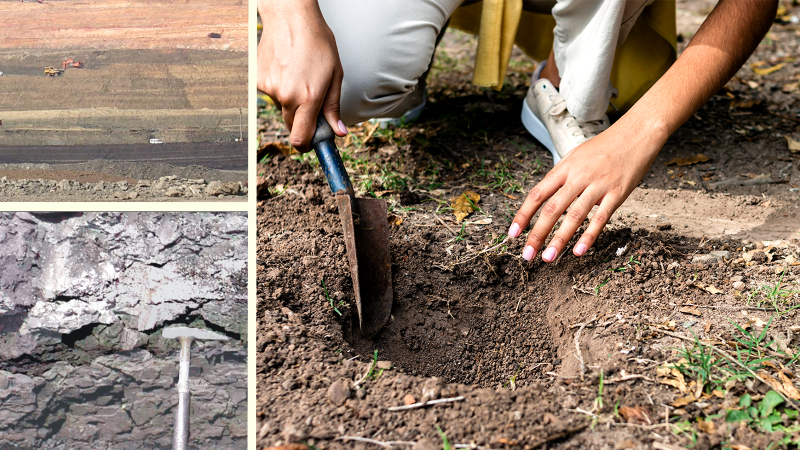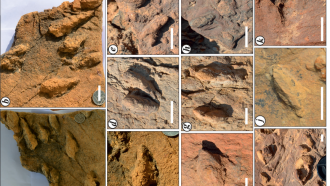
Credit for images on the left: Prasad et al. 2013
About 180 million years ago, as the single landmass Pangea divided into pieces, the parts drifted apart as continents. Animals migrated to neighbouring continents and adapted to new environments not similar to their habitual place. A few of the beings evolved with new characteristics—like the emergence of the trunk in elephants and the long neck in the Giraffe to reach tall trees—while many others could not survive the change in climate and became extinct.
Plants could not migrate as animals did. But pollen from plants could travel with the wind and water, and animals carried them. As the pollen fell on the ground, it mixed with the soil and remained within the strata. A stratum is formed when the multiple layers of soil deposits are stacked one above the other. Paleobiogeography, studying pollen deposits in the strata formed over thousands or even millions of years, can explain how the plants have evolved over the years at different geographic locations.
Dr Vandana Prasad and her team from Birbal Sahni Institute of Palaeosciences, Lucknow, studied fossil pollen of specific plants from a subfamily called Crotonoideae that show a typical pattern of pollen. The pollen of plants under Crotonoideae show a hexagonal or circular arrangement of bead-like structure on the pollen wall, known as the croton-pattern. The team studied various pollen types from the Indian strata and compared the recovered fossil pollen with those in other geographical regions. They also assessed the botanical affinity of all the discovered pollen fossils by investigating similarities in pollen morphological characters with the pollen of living plants. The researchers presented a detailed list of previous research publications that include Crotonoideae fossil pollen studies conducted across the world. They used the data from these studies to compare the similarities among pollen distributed in differential space and time. It helped them understand the different stages of adaptations the pollen might have undergone during different geological periods.
More about Pollen
Pollen or pollen grains are present in stamens, the male parts of a flower. Winds, insects or birds carry them to pistils which are the female parts of the flower. The process is called pollination, and it results in the formation of seeds from which a new plant grows. However, not all pollen grains reach the female part of a flower. A few grains fall on soil and get buried in it. As layers of soil pile up on the pollen for millions of years, these pollen become a part of the fossils created. Today, we can study such fossil pollen, and it can give us a clue about the kind of plants that were present millions of years ago, even though the plants may be extinct now.
“Pollen grains are made up of a compound called sporopollenin that can sustain any physical and chemical weathering. This property enhances the preservation potential of pollen grains in million-year-old strata,” says Ms Mahi Bansal, first author of the paper.
Plants from the subfamily Crotonoideae are of significant economic importance because of their medicinal properties and their use in extracting rubber, oil, biofuel production and horticulture. Typically, Crotonoideae pollen are spread in humid to semi-humid regions.
Structure of fossil pollen

Image: Scientifickly
Based on the physical appearances of pollen fossils collected in India, the team constructed a flow chart to compare the pollen characteristics with previously published fossil pollen records of the same plant group from across the world. They noticed that many of them resemble the Crotonoideae fossils of South America and Africa. Some fossil pollen discovered by the team were new to the Crotonoideae fossil literature. The pollen fossils were then matched with their worldwide living relatives. Each fossil pollen exhibited a wall structure called exine that varied in thickness, shape and croton-pattern. Croton-patterns in all pollen were pentagonal or hexagonal in outline with round or triangle shaped subunits. However, the tips or apices varied in shape. Though the croton-pattern is not restricted just to the Crotonoideae plants, the exine wall structure is unique to them. The outer walls of Crotonoideae pollen are sculptured with standing cylindrical or elongated bead-like arrangements called clava.
The Journey of Pollen
When the Pangea landmass split and the pieces were drifting away, the Indian plate separated from the rest of the land, moved towards the equator, drifted further northwards and collided with the Asian plate 55 to 34 million years ago. The thrust due to collision led to the formation of the Himalayan mountain range that created seasonal aridity over the Indian land. The arid climate and mountains acted as a barrier to the further distribution of pollen belonging to the plants that grow well in wet conditions. The analysis of fossil pollen embedded in the strata shows how the Indian plate served as a ferry to carry the floral biota (the whole plant environment including soil characters and land) when it sailed away from South to North.
Himalayan uplift and the formation of mountains blocked the flow of wind and created extreme seasonal cold-hot and humid climates in India, very different from the climate before the collision. This climate change resulted in the extinction of plants such as Endospermum, Klaineanthus and Tetrorchidium, which were dominant in wet habitats of the Indian plate before the India-Asia collision. At the same time, the species of plants Croton and Jatropha adapted themselves and were able to disperse from India to coastal areas of Southeast Asia (Malaysia, Sundaland) after its collision with the Asian plate. Endospermum could also migrate to Southeast Asia but didn’t survive the harsh climatic conditions over the Indian subcontinent. Thus, the species recorded from the geologically older Indian strata are those that adapted to new environments as well as the species that became extinct.
Pollen fossils in India
The team studied pollen fossil samples from sediments collected at four locations in Madhya Pradesh, Rajasthan and Gujarat and compared the data with the currently existing pollen forms of Crotonoideae and if there were any similarities with previously recorded fossils at a global level. They also observed the collected pollen under a light microscope and scanning electron microscope.
After the detailed morphological study, they inferred that the pollen fossil found in India showed resemblance with the still existing plants of Crotonoideae called Jatropha, Croton, Endospermum, Klaineanthus, Blachia and Tetrochidium. Endospermum and Klaineanthus pollen plants are currently endemic to tropical rain forests of Southeast Asia and Africa, respectively. However, the current study found their pollen from 66–54 million years old Indian sediments. The present study also found the pollen of the plant Blachia as the first-ever fossil evidence from Gujarat mines. A species of the plant Tetrorchidium, which is presently endemic to South America, was also found in 68–66 million years old sediments of Central India. The sediments were from the time when India was connected with Africa. The study tells that Tetrorchidium originated in Africa and was later dispersed to South America and India when the three landmasses were still close to each other.
In the current study, the recovery of Blachia pollen fossils for the first time is a good example of evolution that the collision of India and Asian plates facilitated. Nonetheless, one of the species of Blachia, once widespread across the Indian subcontinent, later retracted to small pockets in wet regions of the Myristica swamps of southern Western Ghats. Exploration and recoveries of pollen fossils, such as in the current study, are helpful for biogeographic studies and bridge the gap between existing pollen fossil records from several geographies. The information can help build a paleobiogeographic history of the significant Crotonoideae plant group.
Crotonoideae encompassing the Croton type pollen is the primitive group (ancestral group) of a flowering plant family called Euphorbiaceae. As the Croton type pollen evolved in response to the changing climatic conditions, its characteristics such as pollen wall thickness, shape and the apices also underwent drastic changes over time. This study opens up the avenues for phylogenetic analysis (study based on physical properties and genetic factors). The analysis would further help identify the species that are close relatives and those that are evolved and separated because of new physical and climatic barriers under the group Euphorbiaceae.
As the Indian plate drifted from Pangea in the south and collided with the Asian plate in the north, the climate on the Indian plate changed drastically during the journey. While travelling, many pollen could not survive the new climatic conditions, while a few species modified their features to suit the new climate. After a certain period post-India-Asia collision, the further dispersal of wet pollen from India to Southeast Asia was restricted due to the upliftment of Himalayan mountains followed by the prevalence of seasonal aridity. Hence, some Crotonoideae species, like the Blachia species, became restricted or endemic only to India.
Ms Mahi Bansal adds, “The morphology of fossil pollen records, when combined with morphological and molecular data of their living relatives, and analysed under the phylogenetic framework, gives a better understanding of the evolutionary history of flowering plants. Once the climatic condition in which a species evolves or goes extinct is understood, it might help the biodiversity conservationists formulate appropriate conservation policies.”
This article has been run past the researchers, whose work is covered, to ensure accuracy.






